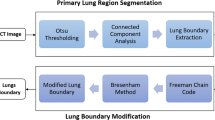Abstract
This study presents a completely automated method for separating the left and right lungs using free-formed surface fitting on volumetric computed tomography (CT). The left and right lungs are roughly divided using iterative 3-dimensional morphological operator and a Hessian matrix analysis. A point set traversing between the initial left and right lungs is then detected with a Euclidean distance transform to determine the optimal separating surface, which is then modeled from the point set using a free-formed surface-fitting algorithm. Subsequently, the left and right lung volumes are smoothly and directly separated using the separating surface. The performance of the proposed method was estimated by comparison with that of a human expert on 44 CT examinations. For all data sets, averages of the root mean square surface distance, maximum surface distance, and volumetric overlap error between the results of the automatic and the manual methods were 0.032 mm, 2.418 mm, and 0.017 %, respectively. Our study showed the feasibility of automatically separating the left and right lungs by identifying the 3D continuous separating surface on volumetric chest CT images.











Similar content being viewed by others
References
Kang MJ, Park CM, Lee CH, Goo JM, Lee HJ: Dual-energy CT: clinical applications in various pulmonary diseases. Radiographics 30(3):685–698, 2010
Goo JM: A computer-aided diagnosis for evaluating lung nodules on chest CT: the current status and perspective. Korean J Radiol 12(2):145–155, 2011
Uppaluri R, Hoffman EA, Sonka M, Hunninghake GW, McLennan G: Interstitial lung disease: a quantitative study using the adaptive multiple feature method. Am J Respir Crit Care Med 159(2):519–525, 1999
Park YS, et al: Texture-based quantification of pulmonary emphysema on high-resolution computed tomography: comparison with density-based quantification and correlation with pulmonary function test. Investig Radiol 43(6):395–402, 2008
Lee CW, et al: A pilot trial on pulmonary emphysema quantification and perfusion mapping in a single-step using contrast-enhanced dual-energy computed tomography. Investig Radiol 47(1):92–97, 2012
Lee YK, et al: Quantitative assessment of emphysema, air trapping, and airway thickening on computed tomography. Lung 186(3):157–165, 2008
Chae EJ, et al: Slope of emphysema index: an objective descriptor of regional heterogeneity of emphysema and an independent determinant of pulmonary function. AJR Am J Roentgenol 194(3):W248–W255, 2010
Chae EJ, et al: Xenon ventilation CT with a dual-energy technique of dual-source CT: initial experience. Radiology 248(2):615–624, 2008
Goo HW, Yang DH, Kim N, Park SI, Kim DK, Kim EA: Collateral ventilation to congenital hyperlucent lung lesions assessed on xenon-enhanced dynamic dual-energy CT: an initial experience. Korean J Radiol 12(1):25–33, 2011
Chae EJ, et al: Collateral ventilation in a canine model with bronchial obstruction: assessment with xenon-enhanced dual-energy CT. Radiology 255(3):790–798, 2010
Sluimer I, Schilham A, Prokop M, van Ginneken B: Computer analysis of computed tomography scans of the lung: a survey. IEEE Trans Med Imaging 25(4):385–405, 2006
Leader JK, et al: Automated lung segmentation in X-ray computed tomography: development and evaluation of a heuristic threshold-based scheme. Acad Radiol 10(11):1224–1236, 2003
Armato 3rd, SG, Sensakovic WF: Automated lung segmentation for thoracic CT impact on computer-aided diagnosis. Acad Radiol 11(9):1011–1021, 2004
Brown MS, et al: Method for segmenting chest CT image data using an anatomical model: preliminary results. IEEE Trans Med Imaging 16(6):828–839, 1997
Hu S, Hoffman EA, Reinhardt JM: Automatic lung segmentation for accurate quantitation of volumetric X-ray CT images. IEEE Trans Med Imaging 20(6):490–498, 2001
Park SC, et al: Separation of left and right lungs using 3-dimensional information of sequential computed tomography images and a guided dynamic programming algorithm. J Comput Assist Tomogr 35(2):280–289, 2011
van Rikxoort EM, de Hoop B, van de Vorst S, Prokop M, van Ginneken B: Automatic segmentation of pulmonary segments from volumetric chest CT scans. IEEE Trans Med Imaging 28(4):621–630, 2009
Bartz D et al.: Hybrid segmentation and exploration of the human lungs. Proceedings of the 14th IEEE Visualization Conference (VIS'03). Seattle, WA, USA, 2003
Chen J, Amini AA: Quantifying 3-D vascular structures in MRA images using hybrid PDE and geometric deformable models. IEEE Trans Med Imaging 23(10):1251–1262, 2004
Sofka M, Stewart CV: Retinal vessel centerline extraction using multiscale matched filters, confidence and edge measures. IEEE Trans Med Imaging 25(12):1531–1546, 2006
Sato Y, et al: Tissue classification based on 3D local intensity structures for volume rendering. IEEE Trans Vis Comput Graph 6(2):160–180, 2000
Fabbri R, Costa LDF, Torelli JC, Bruno OM: 2D Euclidean distance transform algorithms: a comparative survey. ACM Comput Surv (CSUR) 40(1):2, 2008
Bailey DG: An efficient euclidean distance transform. Springer, Berlin, 2005
Maurer Jr, CR, Qi R, Raghavan V: A linear time algorithm for computing exact euclidean distance transforms of binary images in arbitrary dimensions. IEEE Trans Pattern Anal Mach Intell 25(2):265–270, 2003
Surface fitting using gridfit. Available at http://www.mathworks.com/matlabcentral/fileexchange/8998. Accessed 11 Sept 2012
Van Ginneken B, Heimann T, Styner M: 3D Segmentation in the clinic: a grand challenge. MICCAI 10:7–15, 2007
Acknowledgments
This work was supported by the Technology Innovation Programs (10041618, 10041605) funded by the Ministry of Knowledge Economy (MKE) of Korea.
Author information
Authors and Affiliations
Corresponding author
Rights and permissions
About this article
Cite this article
Lee, Y.J., Lee, M., Kim, N. et al. Automatic Left and Right Lung Separation Using Free-Formed Surface Fitting on Volumetric CT. J Digit Imaging 27, 538–547 (2014). https://doi.org/10.1007/s10278-014-9680-5
Published:
Issue Date:
DOI: https://doi.org/10.1007/s10278-014-9680-5




